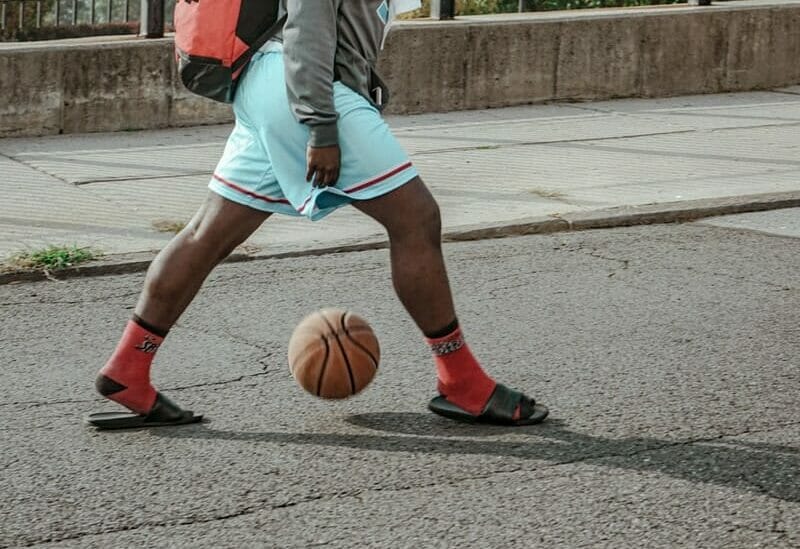As basketball fans gear up for another season of competitive play, they must also make sure that their game ball is properly inflated. Did you know how much air should be in a basketball? If the ball is not at the optimal air pressure, it will not bounce correctly and players may lose possession or miss more shots than normal. In this blog post, we will discuss how to inflate a basketball and how to tell if it is properly inflated.
Find the best basketball pump
If you need an air pump for your basketball, check out the latest models and prices on Amazon. Of course, you can use most pumps that you use for your car tire or your bike tire, provided that you also have a pump needle in hand.
What is the proper air pressure for a basketball and why is it important?
A basketball needs to be inflated to between 7.5 and 8.5 PSI (pounds per square inch). If the ball is not properly inflated, it will not bounce as high or as well. This can lead to players losing possession of the ball or taking more shots than they would if the ball were properly inflated. The NBA also regulates that an NBA basketball between 7.5 and 8.5 psi. In any case, most basketballs do have inflation instructions printed next to the inflation valve.
How do you measure the air pressure in a basketball correctly and what tools do you need to do so?
You can measure the air pressure in a basketball using a ball pump and a pressure gauge. First, use the ball pump to inflate the ball to the desired air pressure. Next, place the pressure gauge on the valve of the ball and check that the reading is correct. If it is not, you can adjust accordingly.
What are some signs that a basketball is not properly inflated?
There are a few signs that you can look for to tell if a basketball is not properly inflated. First of all, it is crucial that your ball has a nice round shape and is bouncing correctly. If the ball does not bounce as high as it should or feels softer than usual, this may be an indication that it needs more air. Another sign is if the ball starts to leak air. If you notice any of these signs, be sure to check the air pressure and inflate accordingly.
How can you adjust the air pressure in your basketball to make it feel just right for you when playing or practicing?
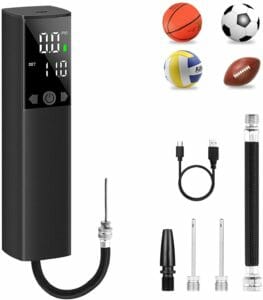
You can adjust the air pressure in your basketball by using an air pump and a pressure gauge. First, use the ball pump to inflate the ball to the desired air pressure. Next, place the pressure gauge on the valve of the ball and check that the reading is correct. If it is not, you can adjust accordingly. If you need to increase the air pressure, pump more air into it. If on the other hand, the air pressure inside is too high, then just put the needle in the ball without the pump attached and let it lose some air down to the recommended air pressure.
What are the consequences of using an incorrectly inflated basketball, both in terms of gameplay and safety?
Using an incorrectly inflated basketball can have consequences both in terms of gameplay and safety. If the ball is not properly inflated, the ball bounces lower or higher than the recommended height. This can lead to players having difficulty controlling or passing the ball properly and also missing more shots than they would if the ball were properly inflated.
Additionally, if the ball is too hard from too much air inside, it may be more susceptible to being punctured. This can cause the ball to deflate suddenly and may injure players who are using it. A hard overinflated ball might also hurt players’ fingers when trying to catch it after a pass or a rebound.
Can over-inflating or under-inflating a basketball have an impact on your shooting or dribbling abilities, and if so, how significant could this be?
Does air pressure affect your game? It definitely does. Over-inflating or under-inflating a basketball can have an impact on your shooting or dribbling abilities. If the ball has more air inside, it will be harder to control as the basketball bounces higher than usual. This could make it more difficult to shoot accurately. If the ball is under-inflated, it will be softer and may not bounce as high. This could make it more difficult to dribble effectively. Either way, it is important to inflate the ball to the correct air pressure so that you can play your best game.
Inflating a basketball to the proper air pressure is important for the game itself and also for player safety. Make sure you have the correct tools such as an air pump and know how to use them so that you can keep the ball inflated properly. This way, everyone can enjoy playing the game without worrying about injury or poor performance.
Should you inflate all different basketballs at the same air pressure?
The air pressure inside a basketball can affect how it feels and how well it performs. As such, you may want to adjust the air pressure depending on the type of ball you are using. For example, an indoor ball might be inflated to a higher pressure than an outdoor ball since it will be used on a softer surface. Also, the adequate air pressure in a basketball depends on the brand make and model, so you should follow the below course of action:
- Check the printed label next to the ball valve for the manufacturer instructions
- Try a ball bounce (or more) to ensure that the ball bounces as required or if you put too little or too much air inside it
A basketball with built-in pump
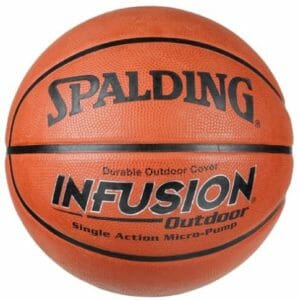
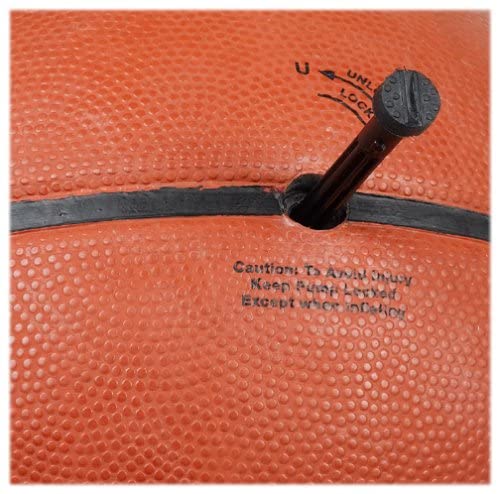
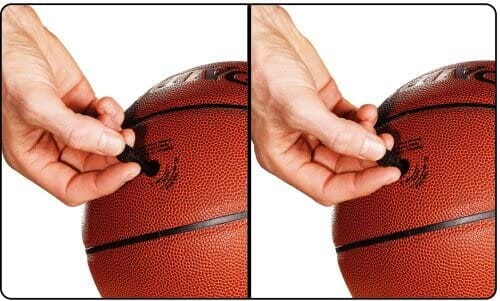
The Spalding NBA Outdoor Infusion Basketball used to be a ball that had a built-in pump. However, the model was not very successful as the pump was not very effective and the ball failed to maintain its bounce for a lot of time. Hence Spalding discontinued the model.
FAQ
How much air should I put in my basketball?
The proper psi for basketball is between 7.5 and 8.5 PSI – pounds per square inch. How much air pressure your ball needs exactly, depends on a lot of factors such as its brand and model, the surface it will be used on and the weather conditions. An NBA basketball fully pumped is between 7.5 and 8.5 PSI
How high should a basketball bounce?
A properly inflated basketball should bounce between 49 and 54 inches when dropped from a height of six feet to a solid surface. How much air pressure you put in your ball depends on how high your basketball bounces to fall within this limit. The proper inflation for a basketball is between 7.5 and 8.5 PSI.
How do you know when a basketball has enough air?
Bounce the ball on the ground and measure the height of the bounce. If the ball bounces within the 49-54 inch range, then it has the optimum amount of air. If not, you will need to add or release air until you achieve the ball to bounce properly.
Can you over-pump a basketball?
Yes. If you pump a basketball too much, the ball will be too hard and might even pop. The ideal PSI for a basketball is between 7.5 and 8.5 PSI. If you find that your ball is inflated at slightly higher air pressure than optimal, then use a pump needle to reduce the amount of air pressure.
Why did my basketball explode?
If your basketball exploded, it was likely over-inflated. The ideal PSI for a basketball is between 7.5 and 8.5 PSI. If you pump a basketball too much, the ball will be too hard and might even pop, especially if you are playing outdoors and it hits a hard surface with an angle
Why do basketballs lose air?
Basketballs can lose air for a variety of reasons. If you notice that your ball is losing air, check the valve to make sure it is not damaged. It is also possible that the ball was not inflated properly to begin with and needs to have more air added. Finally, if you are playing on an outdoor court, the surface may be too hard and cause the ball to lose air more quickly. Finally, the increased temperature might increase the inner pressure, and the air escapes. Then inevitable when the temperature cools, the air pressure is lower.
What is the best way to store a basketball so that it keeps its pressure?
The best way to store a basketball is in a cool, dry place. Do not leave the ball in direct sunlight or a hot car, as this can cause the ball to lose air more quickly. If you are not using the ball for a long period of time, it is best to deflate it slightly so that the pressure does not build up too much and cause the ball to explode.
How to fix a basketball that won’t hold air?
There are a few things you can try to fix a basketball that won’t hold air. First, check the valve to make sure it is not damaged. If the valve appears to be fine, try inflating the ball again and making sure that you do not over-inflate it. It is also possible that the ball was not inflated properly to begin with and needs to have more air added. Finally, if you are playing on an outdoor court, the surface may be too hard and cause the ball to lose air more quickly. Make sure to store your ball away from excessive heat or cold when not playing.
How to deflate a basketball?
To deflate a basketball, press down on the valve using a pump needle to puncture the ball and let the air out that way.
Conclusion
Now that you know how to keep your basketball fully pumped, you can properly inflate your ball before your next game. Remember to check the manufacturer’s instructions for the specific PSI requirements for your ball. You should also test the ball’s bounce to ensure that it has the proper amount of air pressure. Too much or too little air pressure can affect how well the ball bounces and how easy it is to handle. With the proper air pressure, you will be able to enjoy a game of basketball to the fullest! Thanks for reading.
- How to Pass a Basketball (5 effective tips) - August 25, 2022
- Learn How to Spin a Basketball on your Finger in less than 3 minutes - July 18, 2022
- Where are basketballs manufactured? (hint : mostly Asia) - June 10, 2022

